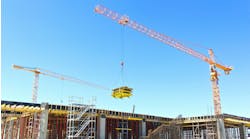Not only did the pandemic cause widespread disruption for the construction industry in 2020, but it has also seriously impacted the number of construction projects being executed in 2021. As a result, the focus is now on looking at ways to “future-proof” construction businesses to navigate uncertain times going forward. However, I’m a strong believer that, in addition to improving productivity, construction companies must also explore new technologies and revenue streams.
According to a recent IFS study, despite the pandemic disruption, 75% of surveyed engineering, construction, and infrastructure organizations have maintained or increased their digital transformation spend. So, although an exact time frame for when the construction market will ultimately recover remains uncertain, companies are using this quiet period to explore digital transformation initiatives to ensure they’re ready to begin operations quickly when the market recovers.
Recovery is at the heart of every company’s contingency plan for 2021 — maximizing revenues and increasing process efficiencies will be key. Following are some key trends I believe will help move the industry toward recovery in 2021:
1. BIM enters a new dimension.
Building Information Modeling (BIM) and its benefits are well known among those in the construction and engineering sector. As a stand-alone technology for 3D design, it has had a huge impact on how complex assets are being developed and built. Some industry stakeholders are currently talking about 4D BIM, which also takes the time and scheduling aspect into account, basically giving companies a video simulation of how (and in what order) an asset should be constructed.
What is not a very mature concept, however, is the combination of BIM with enterprise resource planning (ERP) software, which is where most crucial business data is stored. This lack of sophistication is odd, given the enormous potential in connecting the two — enter 5D BIM.
With the fifth dimension being money, I predict that the challenges of 2020 will provide added incentive for companies looking to bridge the gap between BIM and ERP. The question is how to take a BIM model and turn it into a cost estimate — and then track the actual costs back to the BIM objects.
Moving away from the traditional bill of quantities, companies are now being asked to bid against a BIM model — a cumbersome process that typically involves a myriad of manual calculations and measurements. As 5D BIM comes to the forefront, I predict companies will start demanding automated tools for transferring BIM models straight into the estimate module of their ERP software. They will expect standard integrations that enable a free flow of data between the different systems. What will be needed are integrations that enable the bid teams to sort and structure the data by type of component, separate them into packages of work, and automatically price each package.
Trailblazers within the construction industry that are already implementing (or trialing) 5D BIM/ERP integrations will use their head start to investigate the sixth dimension of BIM: maintenance. At this stage of the maturity cycle, the visualization element of BIM takes a subordinate role to the free flow of information throughout the life cycle of the asset — from design to build to maintenance. While still a few years out, I predict a rapid progression to 5D and 6D BIM.
2. Through-life service replaces traditional construction-only approach to projects.
The financial impact of the pandemic on the construction industry means that reliable and robust revenue streams have become critical for construction companies. This has led many to transform themselves from traditional organizations to asset life cycle service providers, able to provide through-life service, facilities management, and maintenance to their clients.
The outcome is a strengthened emphasis on total life cycle cost rather than the traditional, one-and-done build cost. One of the major implications is the profound shift in focus among the companies building the assets. As they will be increasingly expected to assume cradle-to-grave service responsibility for each asset they build, they will need to focus on asset quality, longevity, and ease of maintenance. Put more provocatively, now that the asset is the construction company’s problem, it will need to be designed for quick and easy repair and maintenance.
As customers are more and more interested in buying outcomes rather than brick-and-mortar assets — for example, hospital beds rather than the building that houses them — construction companies will need to get used to providing an all-encompassing service offering.
A majority of stakeholders in the construction and engineering space are still doing business through two separate contracts — one to build and one for service. In 2021, however, I predict we will see an increase in the number of companies transitioning to a single contract that spans the entire life cycle of the asset while regulating its output or availability.
A move to total asset life cycle responsibility will mean a complete overhaul of business models as companies will need to extend their planning horizons significantly to ensure long-term profitability. Even if they have competent staff to attempt this transformation, it is likely many will initially struggle to establish best practices in service processes that will ensure delivery of new-to-them concepts, such as customer engagement, service-level agreements (SLAs), and field service scheduling and optimization. One of the ways to solve this is to look at enterprise software designed to power the transformational journey from construction-only to through-life service provision.
3. Offsite construction brings supply chain management into focus.
An increasingly popular trend within the industry is offsite construction or prefabrication. Whereas construction companies used to build a house using materials shipped to the site, many companies today are moving the actual construction to factory-like, indoor environments where tradespeople and contractors build components or modules that are shipped to and assembled on the building site. One of a vast number of examples of this trend is engineering firm Babcock, which delivered prefabricated components to the Heathrow Terminal 5 project.
This style of construction requires much more complex logistics for each build than traditional on-site building methods; therefore, we will see a significant uptick in companies focusing on implementing supply chain management best practices. The vast majority of traditional construction companies will admit to having very little experience in working with things like parts numbers and inventory. The supply chain-centric work processes of a company like Amazon will not reflect the current reality of their businesses. Yet, this is the vocabulary they will need to learn (very quickly) in order to effectively and profitably manage the logistics challenge of getting hundreds or even thousands of prefabricated components to one or more construction sites — at the right time and in the right order.
I predict the construction industry will see accelerated investments in business software capable of imposing order on a supply chain-driven transformation that would otherwise spin rapidly out of control. Companies will increasingly turn to a manufacturing ethos as they get used to the idea of building standardized components with serialized part numbers that can be used in multiple projects, as opposed to costly, customized solutions.
2021 will be the year when the inexorable march of offsite construction compels traditional construction companies to evolve and come to grips with the urgent need for standardization, both in terms of materials and work processes.
Ingram is the vice president of engineering, construction & infrastructure at IFS, with U.S. headquarters based in Chicago.






